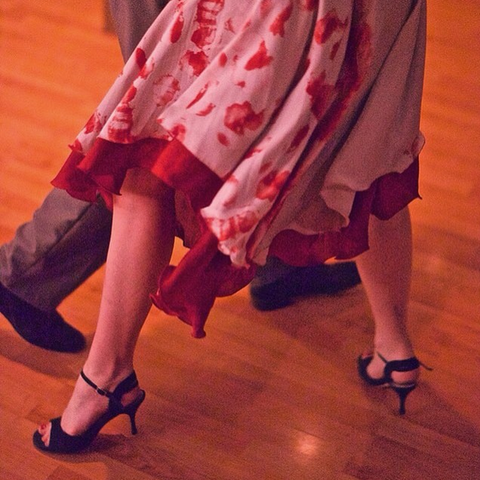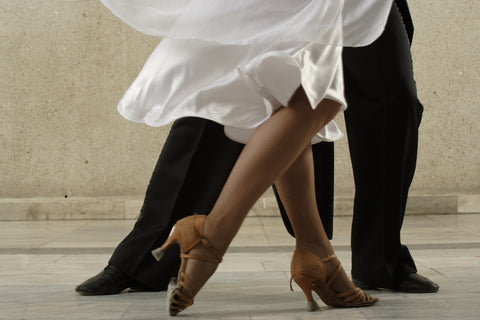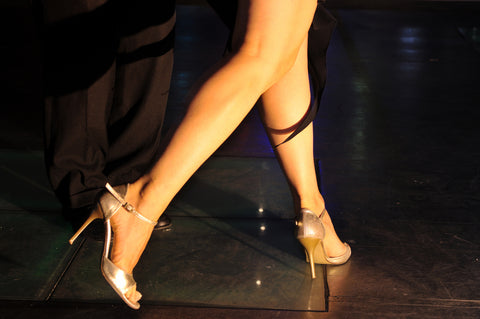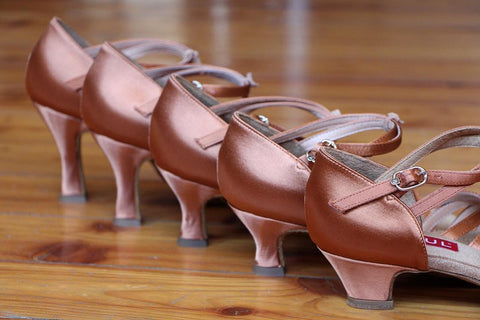

Buying imported Tango shoes is a major investment, and sometimes it's hard to tell how you feel about that new pair of Italian tango shoes until a few milongas in. Here are some tips for finding the best quality tango shoes with the right sized heels for your needs.

Low heels are a great option for beginners and for those who want more stability. Why? Because your axis in low heels is the most similar to your axis in no heels. Low heels offer a greater range of error when it comes to axis placement since you have a larger "base" for your body in the long horizontal length between the ball of your foot and heel.
Think about balancing a book on top of a bowl. The bowl's base is larger and more stable than, for example, a coffee mug's base, which means that keeping the book balanced on the rim isn't too hard, even if the book is slightly off center.
If low heels sound like the perfect fit for your tango, you may like these pairs of low heel tango shoes.

These are great for an intermediate or above dancer, and for those who want a more traditional tango look. They are also the most common heel heights you'll find among all brands. Medium heels give your body a medium-sized "base" (horizontal length between ball and heel) which means that smaller degrees of body tilt and movement will have a greater effect on the axis than low heels.
Balancing a book on top of a coffee mug is still possible but requires a higher degree of precision than balancing a book on a bowl.
One benefit of medium heels over low heels is that when walking backward, you'll have less distance to travel to regain your center. As a beginner, it can be uncomfortable to walk backward and not see where you're going or know when your foot will hit solid ground. Medium heels mean that your foot will hit solid ground sooner than in low heels.
You may want to try these traditional medium heeled tango shoes for you needs if a solid center is what you are looking for in your practice!

High heels can have a stunning effect on a follower's dance, extending the follower's lines and emphasizing the feminine movement of the body. Think of balancing a book on top of a champagne glass--very pretty, but less room for error, and easier to knock off axis! However, along with balancing on a smaller "base," you'll encounter issues of foot flexibility and strength.
First, high heels "push" your weight more toward the ball of your foot by default, so it's important to still be able to find an even weight distribution on a small base. A small base can cause fatigue to set in faster, especially if the sole of your shoe does not have much padding.
Second, high heels require high foot flexibility since you need to be able to roll through the ankle and foot naturally, when you want to. This involves having the ability to lift your heel tips off the ground in a straight-leg relevé (depends on foot flexibility) without sickling (depends on strength). Foot strength and flexibility test follows in the next section.
If you're an expert in tango, these high heel tango shoes will show off your flair and style!
Stand flat-footed on the ground. Draw an imaginary line from the ball of your foot to your heel. See how it is parallel (180 degrees) to the ground.
Go on "tippy toes." Look in a mirror to see how that imaginary line moved. Now it might be at a 45-degree angle to the ground. The closer it is to 90 degrees, the higher your foot flexibility is.
Stay on "tippy toes" and look down. Look at how the shape of your foot follows the rest of your leg. Your weight should be evenly distributed on the front of the foot (ball and toes), not leaning out toward the pinky toe (sickling, also known as banana foot) and not leaning in toward the big toe (winging, which is sometimes a desired look but is very easy to misunderstand and misuse).
If your foot is sickled or winged, bring it to a straight, balanced alignment.
Check to see how the angle between the ground and your imaginary line from "step 2" has changed, if at all. It is common for this angle to be smaller than the angle you had in "step 2," since sickling/winging often occurs as compensation for low foot flexibility.
Remember the angle you see in "Step 5"! What you see here is your body's current abilities, which you should take into consideration when choosing a heel height. There is no "ideal" body type for tango, so if you have low foot strength and flexibility, don't worry. While you can strengthen and stretch your feet to some degree, it's a better idea to work with your strengths, and adapt your tango to them.

Practice heels look like lace-up sneakers with a low, block heel. They provide a great deal of structure and support to the foot, and the heel itself has a large surface area for high stability. These are great for leading, switching off between leading and following, and for saving your feet when you know you've got a busy night ahead of you.
Extra-Stable heels have thick, shorter heels that create a larger surface area to balance on. While there are fewer styles available, the trade-off of stability for fashion might be worth it. Of course, Axis Tango may have a collection that is both stable and stylish.
Some heels taper to a round point while others have a flared base. The more surface area the tip of the heel has, the more stable your foot will be, providing that the rest of the shoe fits well too. More surface area means a more evenly distributed weight, and less stress on your body.
Looking at a shoe from the side, you might notice that some heels are placed more toward the back of the shoe, while others are placed more forward, toward the center of the sole. Depending on how much your foot fits the back of the shoe (and whether it's a caged heel or strappy heel), the shoe's heel placement might affect where you find your axis. This does not affect the concept of a bowl, mug, and champagne glass balancing. Heel placement is about how the individual foot fits into the shoe.
The best quality tango shoes should always be well-balanced and relatively comfortable from the start. They are meant to be natural extensions of your body and to enhance your tango in the way you want to dance it. While you can passably dance in any high-quality tango shoe, it's much easier and better for the body to dance in ones that complement your own movement style and abilities. There are so many gorgeous, imported tango shoes for women, that you really want to make sure that that pair of glittery gold, Italian-made tango shoes that you've been eyeing are the ones for you!